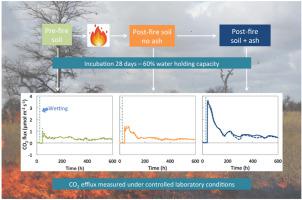Soil Biology and Biochemistry ( IF 9.7 ) Pub Date : 2021-06-10 , DOI: 10.1016/j.soilbio.2021.108334 Carmen Sánchez-García , Cristina Santín , Stefan H. Doerr , Tercia Strydom , Emilia Urbanek

|
Savannah fires are the largest contributor to global carbon (C) emissions from vegetation fires as a result of their high frequency and the large area burnt each year. Fires not only emit CO2 during the combustion process, they can also lead to enhanced CO2 fluxes from affected soils and vegetation, especially during the initial post-fire recovery period. Wildland fire ash is a ubiquitous product of vegetation fires known to enrich the nutrient content and pyrogenic C (PyC) of the underlying soil, and is expected to stimulate soil C fluxes in the post-fire period. However, the role of ash in post-fire soil C fluxes has rarely been examined. Thus, we investigated the effects of fire and wildland fire ash on CO2 fluxes from fire-affected savannah soils. Soil and ash material were sampled from three sites in an African savannah in the Kruger National Park (South Africa) before and immediately after experimental fires. CO2 fluxes from homogenised natural soils and ash were continuously monitored for 28 d in a laboratory incubation experiment under controlled conditions (20 °C, 60% water-holding capacity). Wildland fire ash enhanced CO2 emissions by up to 3 times compared with pre- and post-fire soils (without ash), likely as a result of the high content of readily available nutrients in the ash. Our results also show that as much as 40% of the total C released over 28 d occurred during a short-lived burst of CO2 (lasting between 20 and 61 h) following wetting of the post-fire soil with ash samples. This study, although based on homogenised soil and ash material, shows that not considering wildland fire ash during post-fire soil C observations will likely misrepresent natural conditions and might lead to underestimations of short-term post-fire C fluxes. The large differences observed between the post-fire soil with ash, and both the pre- and post-fire soil without ash, clearly suggest that ash is a key player in C fluxes and should be taken into account in post-fire C cycling studies. Our results also highlight the importance of high frequency observations during the short-term period following wetting of fire-affected soils, since bursts of CO2 upon wetting of burnt soil can comprise a substantial fraction of total C emissions from burnt savannah soil.
中文翻译:

野火灰增强了南部非洲大草原土壤中的短期 CO 2通量
热带草原火灾是植被火灾造成的全球碳 (C) 排放的最大贡献者,因为它们发生频率高,而且每年燃烧面积大。火灾不仅会在燃烧过程中排放 CO 2,还会导致受影响土壤和植被的CO 2通量增加,尤其是在火灾后的初始恢复阶段。野地火灰是一种无处不在的植被火灾产物,已知可以丰富底层土壤的养分含量和热解碳 (PyC),预计会在火灾后时期刺激土壤碳通量。然而,很少研究灰分在火灾后土壤碳通量中的作用。因此,我们研究了火和野火灰对 CO 2 的影响来自受火灾影响的热带草原土壤的通量。在实验火灾之前和之后立即从克鲁格国家公园(南非)的非洲大草原的三个地点采集土壤和灰烬材料。在实验室培养实验中,在受控条件(20°C,60% 持水量)下连续监测来自均质天然土壤和灰烬的CO 2通量 28 天。与火前和火后土壤(无灰)相比,野地火灰使 CO 2排放量增加了多达 3 倍,这可能是因为灰中易获得的养分含量高。我们的结果还表明,在 28 d 内释放的总 C 中多达 40% 发生在短暂的 CO 2爆发期间(持续 20 到 61 小时)在用灰烬样本润湿火后土壤之后。这项研究虽然基于均质土壤和灰分材料,但表明在火灾后土壤碳观测期间不考虑野地火灰可能会歪曲自然条件,并可能导致对短期火灾后碳通量的低估。在有灰烬的火灾后土壤与没有灰烬的火灾前和火灾后土壤之间观察到的巨大差异清楚地表明,灰烬是 C 通量的关键参与者,应该在火灾后 C 循环研究中加以考虑. 我们的结果还强调了在受火影响的土壤润湿后的短期内进行高频观测的重要性,因为 CO 2 的爆发 被烧过的土壤润湿后的碳排放量可能占烧过的稀树草原土壤的总碳排放量的很大一部分。



























 京公网安备 11010802027423号
京公网安备 11010802027423号